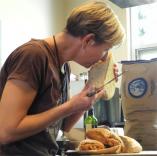 Raj Patel made a welcome visit to Victoria last week, supporting the Horticultural Centre of the Pacific’s efforts to raise funds to rebuild the greenhouse, gardener’s office and tool shed that were destroyed by fire last year. For such a high profile name and entertaining speaker there was a puzzling number of empty seats, but those who came were treated to a whirlwind tour through the complexities of feeding an imbalanced world.
Raj Patel made a welcome visit to Victoria last week, supporting the Horticultural Centre of the Pacific’s efforts to raise funds to rebuild the greenhouse, gardener’s office and tool shed that were destroyed by fire last year. For such a high profile name and entertaining speaker there was a puzzling number of empty seats, but those who came were treated to a whirlwind tour through the complexities of feeding an imbalanced world.
Author of Stuffed and Starved and The Value of Nothing, Patel is fond of an hourglass metaphor (you can see this graphic explained on page 3 of Food Security in a Volatile World) to explain the world’s food economies. Consumers are the numerous bulge in the hourglass’s wide top, farmers & producers make up the wide bottom, and a few corporations act as gatekeepers, pinching the middle and squeezing profits from both ends. The aim, he says, is to try to keep those corporations out of the relationship between consumers and producers: in that way, food can be fairly exchanged and there is no need for hunger.
We do have enough food for the world, we just don’t distribute it well, because we’ve commodified it and a small minority is fixated on making large profits rather than nourishing populations. What we have is wasted and poorly distributed. India leads the world in diabetes – some cities have 20% rate. In his own family every man over 50 must watch his blood sugar.
He spoke about market economies and the disastrous effects they’ve had on food security by removing the obligation found in, for example, feudal economies, where the landlord ensured that food was distributed in times of hardship. In a market economy, there is no such concept. In India, he said, a nation of farmers, the market economy was forced upon a working feudal system by the British, who reaped vast financial rewards and left the country in economic ruin. Where famines had happened once in a hundred years in India, after the British occupation they occurred every four years.
Market economy damages food security by treating food as infinitely produceable and marketable, failing to recognize that it takes time to grow and produce: if there’s a food shortage, it can’t be solved until the crop comes in. Patel reminded us of the concept of grain reserves – a tradition of grain stores whose loss puts the world at tremendous risk. The Mayans, he said, had enough for 15 million people for 6 months; the US public corn store has enough for 9 hours. This is a public grain store: there are private ones, but this will not feed a hungry public in times of need.
Haiti was another example of a food economy crippled by the imposition of a market economy. It had been self-sufficient in rice, but following American intervention and then an American-backed coup, Haiti made a forced entry into market economy. Local rice farmers were swiftly driven out of business by subsidized American rice farmers. There was widespread deforestation and poverty. Farmers were driven into cities to work in sweatshops. Even before Haiti’s earthquake, the country was being hammered into worse poverty by the likes of economist Paul Collier who maintained that Haitians could pull themselves out of debt if the 8 hour sweat shops were made 24 hour (workers were being paid around $3 a day at this time and the American government cooperated with such profitable US clothing companies as Fruit of the Loom, Hanes, Dockers, Nautica and Levi’s in stalling a minimum wage increase to $5 a day, which we now know thanks to WikiLeaks).
Patel expended much of his venom on the World Bank, where he once worked. To illustrate its workings he suggested we watch the Terry Gillian film Time Bandits, in the scene where Robin Hood distributes goods to the poor, while a big thug behind him punches the peasant in the face. And that, he said, is the world Bank. It goes around setting up market economies and lending money that can’t be repaid. Lending more money to cover the debts.
He turned to agriculture, at the root of the food security issue. GMO crops are said to be more productive, he observed. In fact they are, but it has nothing to do with genetic manipulation: it is that seed companies are dedicating their conventional seed breeding efforts to develop the strains that they are pairing with the GMO. So it’s not technology, it’s old fashioned seed breeding that’s improving the yields; but it’s the genetic manipulation of those strains that makes the improved varieties unavailable to organic farmers and those who don’t want/can’t afford to invest in GMO.
He mentioned as well one of the great media blackouts of the past five years: the IAASTD report (Agriculture at a Crossroads) was buried after 4 years work by 400 scientists from 64 countries, working under the request of the United Nations to predict ways to feed the world’s population. The report to its cost said industrial agriculture has had its day and that small scale ecological farming methods are our only hope. Biotech might have a role to play, the report said, but the jury was out.
In brighter news, he spoke about food sovereignty initiatives in Malawi where they’re growing millet, sorghum, cow peas – traditional subsistence crops grown for local consumption. In what sounds like a permaculture move to me, they’re also growing leguminous trees which will also fix nitrogen in the soil while providing shade: 15% more shade means 15% more yield – these are the practicalities of climate change. Despite the success of these crops, children are going hungry, because harvest is woman’s work. Gender roles impair success, so to counter this they’re holding cooking parties, where men, women and children cook together: the women teach the men how to cook.









